Arachnaphobes beware! Spiders are common in California, including Los Angeles. The city, famous for its crowded streets and tall buildings, is also home to many different kinds of spiders. You can often find these little creatures in gardens, parks, and sometimes in houses, too! So, unknowingly, you may be sharing your LA home with these eight-legged creepy crawlies! Will you be encountering spiders on a daily basis in Los Angeles? Absolutely not! Don’t worry, this isn’t Australia.
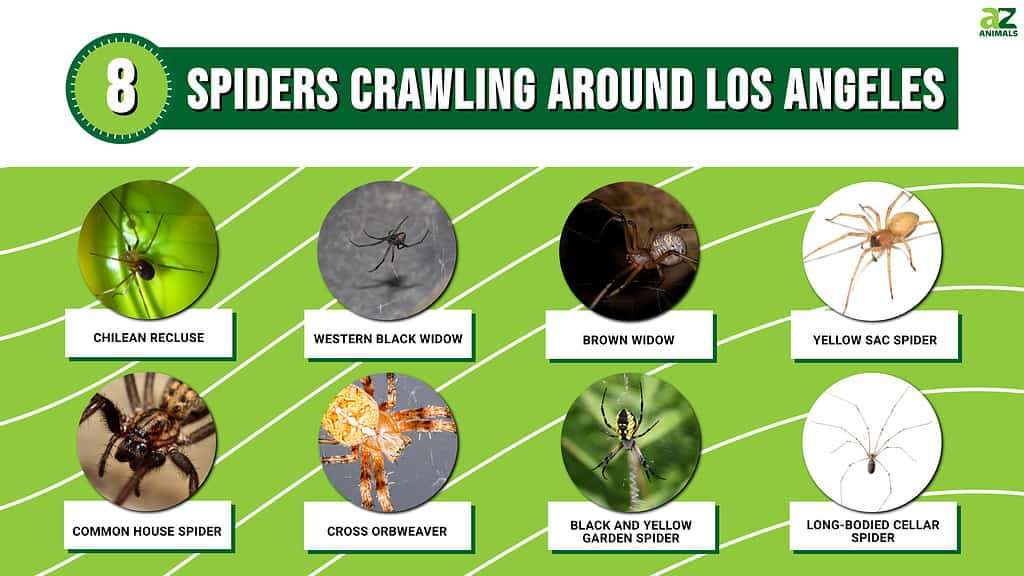
That said, there are plenty of venomous and non-venomous species in the city that you will frequently spot! In this article, we will discuss some of the most common spiders spiders you might see in Los Angeles. But keep in mind a few of these spiders are venomous, so be careful!
Let’s begin this little journey exploring the spiders found in Los Angeles.
Venomous Spiders Crawling Around Los Angeles
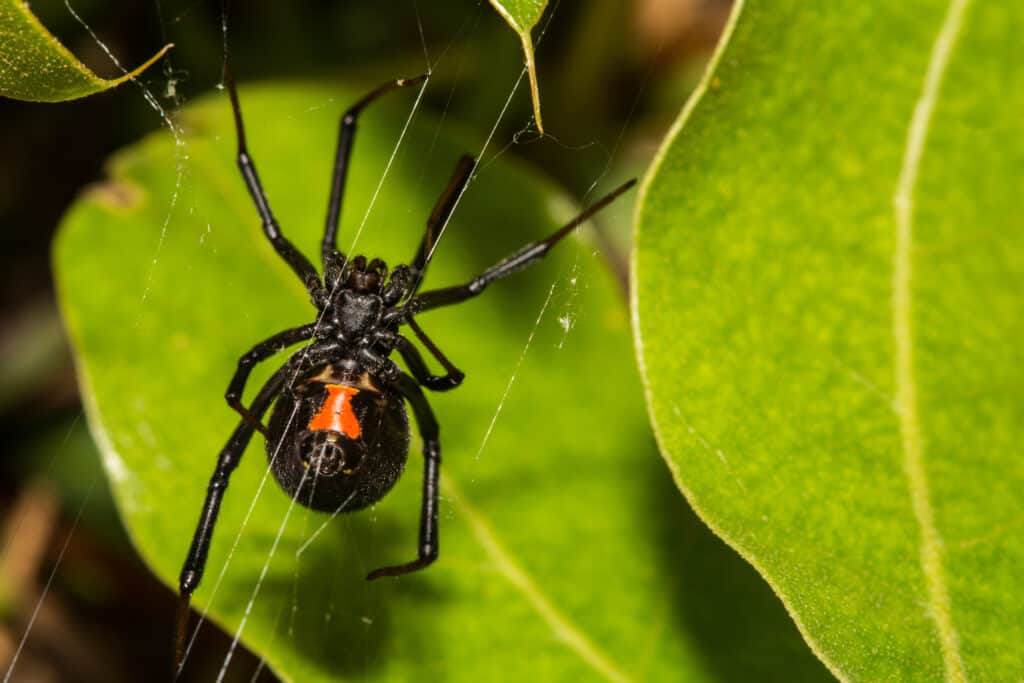
Four venomous spider species have been spotted in Los Angeles, but encounters with humans are rare in the city.
©Jay Ondreicka/Shutterstock.com
There are more than 60 unique spider species in California, but with that said, only 5 of these species are venomous. The only venomous spider species that has never been spotted in Los Angeles is the desert recluse, which is found in the desert regions east of the city. Here are the 4 venomous spider species you can find in Los Angeles.
1. Chilean Recluse (Loxosceles laeta)
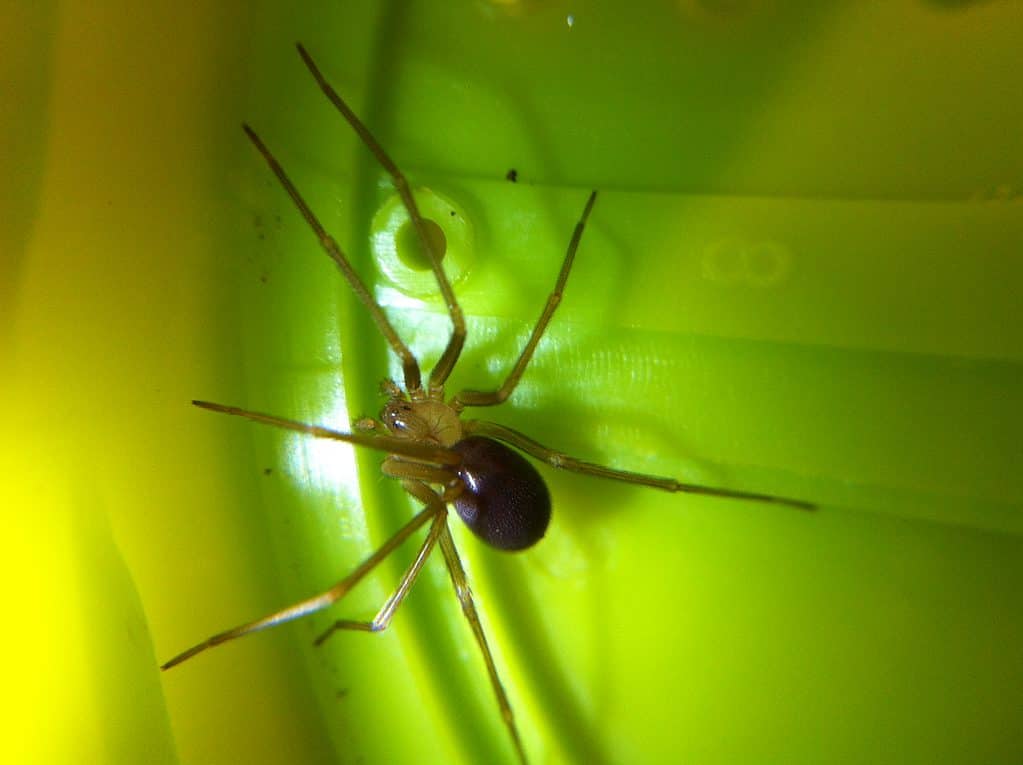
Chilean recluses are invasive in California and extremely rare. But, there have been sightings of the venomous spider in Los Angeles.
©Yabedanie_SA4.0 – License
As its common name may suggest, the Chilean recluse spider is not originally from the United States, but from South America. That said, it now lives in many areas of the USA, including Los Angeles. These spiders are by no means a common sight in LA, but there have been some reports of isolated populations in the city.
While it looks like many other recluse spiders, it’s a bit bigger, growing up to 5/8 inches long. Its body can be a light yellow or reddish-brown shade. You might see a dark, violin-shaped mark on its head, but this can be difficult to notice. Interestingly, all recluse spiders only have 6 eyes as opposed to eight!
These spiders feed on many kinds of small insects, including flies, mosquitoes, moths, and cockroaches.
In their natural habitat, they prefer concealed spaces like underneath stones or within logs, seeking refuge in any available shelter. These spiders also find residence in quiet, dark corners of homes.
The venom of the Chilean recluse can lead to severe tissue damage. This makes it one of the most venomous spiders currently residing in Los Angeles.
Its bites are linked to a few fatalities in South America, but they are generally accidental, occurring when humans inadvertently come into close contact with them. Chilean recluses are not generally aggressive towards humans, so bites are very rare. Initially, a bite might cause mild to moderate discomfort, potentially escalating to intense pain several hours later, accompanied by redness and swelling in the affected area.
2. Western Black Widow (Latrodectus hesperus)
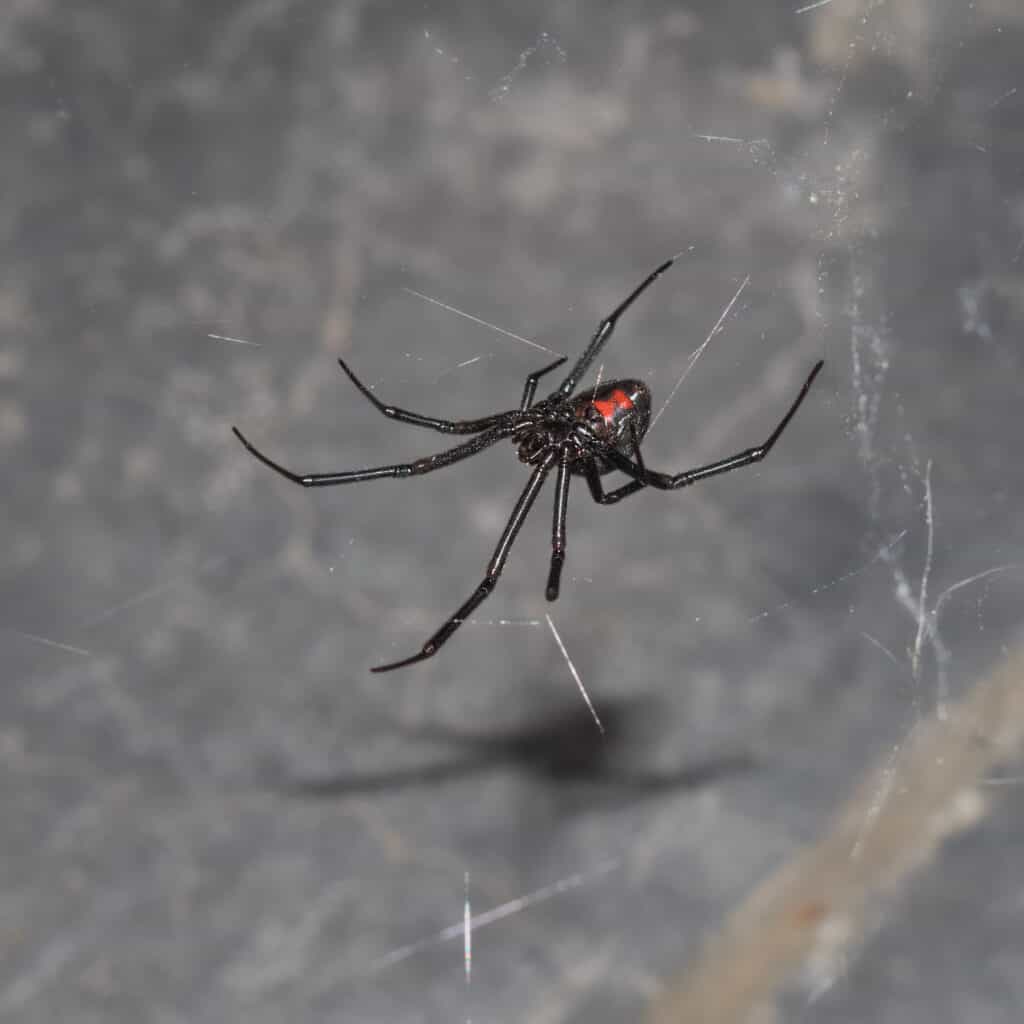
The western black widow is one of the most venomous spiders in North America.
©iStock.com/Shravan Sundaram Photography
Probably the most iconic venomous spider in the world is the black widow. There are several black widow species in the USA, but in California, the western black widow is the most common. The western black widow lives in many populated areas across California, including the city of Los Angeles.
These spiders are relatively small, measuring between 0.27 and 0.6 inches in length. They possess a large abdomen complemented by eight tiny legs. Their black bodies are adorned with a red, hourglass-shaped design on the abdomen’s lower part. Generally, the females are noticeably bigger than the males and sport a less intense color.
Their diet mainly consists of insects, but they won’t shy away from consuming woodlice, diplopods, chilopods, and other spiders when available.
These spiders commonly find a dwelling in pre-existing hideaways in dark and quiet locations. Thus, they are usually spotted in deserted rodent dens, gaps amidst rocks or wooden stacks, or secluded corners in rooms, garages, and other structures.
Amongst spiders found in North America, the female western black widow is one of the most venomous, with venom 15 times more potent than many rattlesnakes. Though not aggressive, a provoked female western black widow can deliver a highly toxic bite that requires medical intervention. In fact, in the USA, black widows are responsible for 4 to 8 deaths per year!
The venom produced by the western black widow is a neurotoxin that affects the nervous system drastically. While some individuals might experience minor symptoms, others could face severe reactions, including intense pain, a burning sensation, localized swelling, and redness.
3. Brown Widow (Latrodectus geometricus)

Originating in South
Africa
, brown widows have set up shop in many parts of the US and are a dangerous invasive species.
©Vinicius R. Souza/Shutterstock.com
The brown widow spider is native to South Africa but made its way to the U.S. via Florida. It was first spotted in Torrance, California, in 2003, and since then, its presence in southern California, including in Los Angeles. Brown widows are considered an invasive species in the USA.
While relatives to black widows, it is easy to distinguish it’s easy to distinguish it from its black and red counterpart. It shows a blend of tan and brown shades accentuated with black markings. Fully grown females often have a linear stripe running down their abdomen’s back and a trio of diagonal lines on each side.
Female brown widows are large spiders that can measure between 1 and 1.5 inches in length when their legs are extended, while males typically reach only half that size.
These spiders feed on common insects like crickets, flies, mosquitoes, ants, and beetles, to name a few. Preferred locations for setting up their webs are usually empty containers such as buckets and pots, as well as corners of entryways, beneath eaves, and inside storage closets and garages.
Though the venom of the brown widow is as potent as that of the western black widow, it is considered less of a threat. This is because they tend to inject less venom when they bite. Moreover, they are rather reserved, avoiding human interaction where possible.
4. Yellow Sac Spider (Cheiracanthium inclusum)
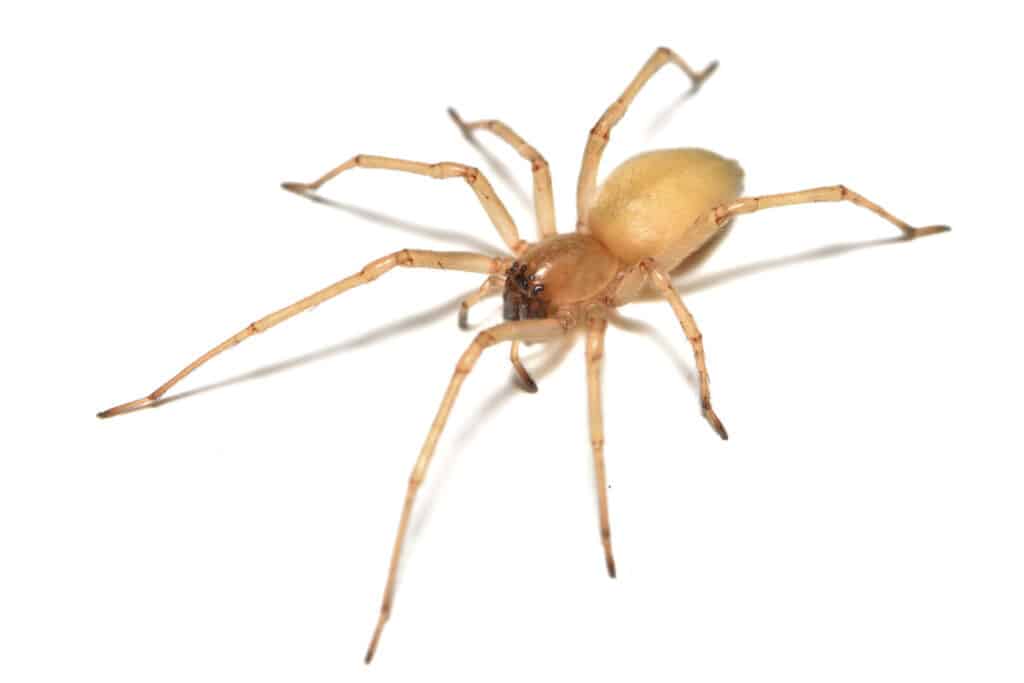
While not as venomous as brown recluses or black widows, yellow sac spiders are another venomous spider you may encounter in Los Angeles.
©Tobias Hauke/Shutterstock.com
In southern California, including Los Angeles, one of the most frequently encountered venomous spiders is the yellow sac spider. Rather than spinning webs, these spiders construct extraordinary chambers for molting.
Yellow sac spiders are very small, ranging between only 1/4 to 3/8 of an inch. They exhibit a light yellow or tan color, with a slightly darker section on their abdomen close to the head region.
The diet of the yellow sac spider mainly consists of other spiders and various pests found in gardens and farms, including their eggs. During times when food is scarce, they might resort to cannibalism, even consuming their offspring. Talk about bad parenting!
These spiders are versatile in habitats, comfortably residing in forests, residences, or gardens. Although they are hunters by nature, they seldom stray far from the vicinity of their resting webs, which are usually within a few yards.
Despite being venomous, the venom of the yellow sac spider is relatively mild, generally not causing any lasting harm. In rare scenarios, some might feel a wave of nausea, and in extremely isolated cases, the bite might lead to the formation of an ulcer or necrotic tissue, although this has only been documented once.
Non-Venomous Spiders Crawling Around Los Angeles
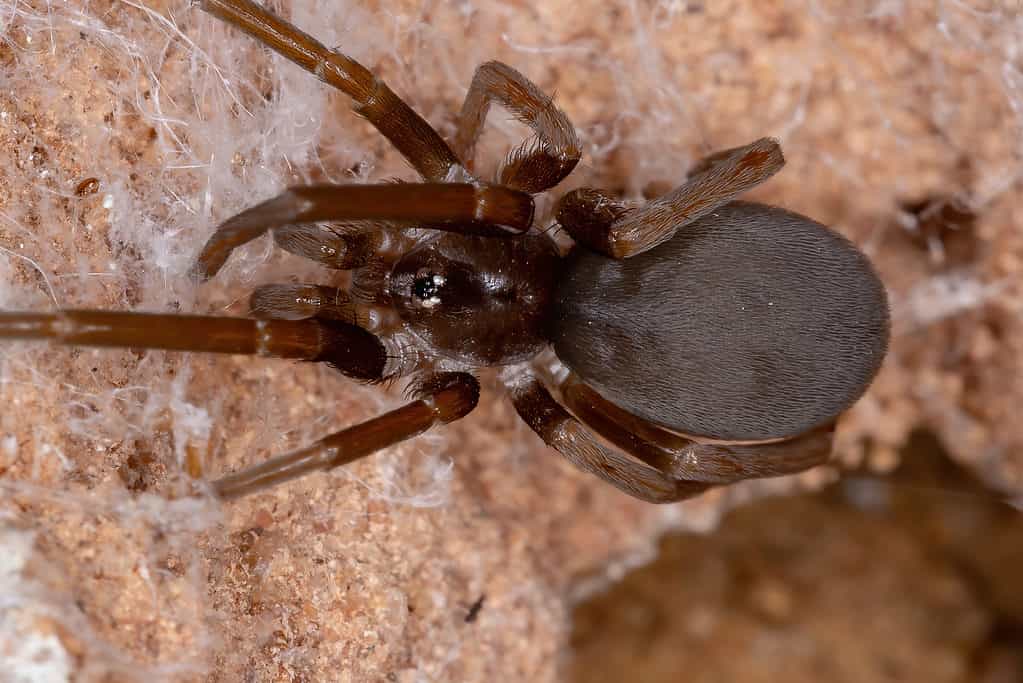
All spiders may give arachnophobes a scare, but non-venomous spiders are not a threat and can even be beneficial as they will eat pesky mosquitos, flies, and other insects.
©Vinicius R. Souza/Shutterstock.com
While there are only 4 venomous spiders you’ll need to worry about in Los Angeles, there are many different species of non-venomous arachnids. Here are a few of the most common spiders in Los Angeles.
5. Common House Spider (Parasteatoda tepidariorum)
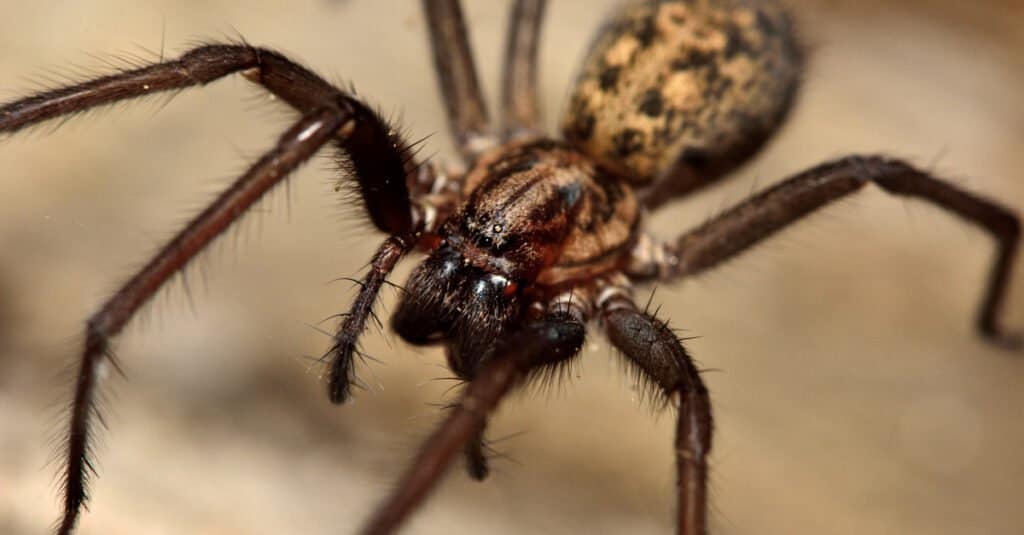
This “beautiful” creature is the common house spider, which is often found in homes, garages, barns, or other man-made structures.
©IanRedding/Shutterstock.com
The common house spider is one of the most frequently spotted spider species in Los Angeles homes.
Female common house spiders measure between 0.19 to 0.23 inches and are characterized by their yellowish-brown head region and pale to brown abdomen adorned with gray chevron patterns. Their legs are yellow, featuring darker bands at the joints. Some even showcase a distinct black, triangular mark atop their abdomen.
These spiders, like all other species, are predatory, feeding on various insects commonly found within households, including flies, cockroaches, earwigs, mosquitoes, and others.
You’ll find the common house spider virtually everywhere – from gardens and yards to indoor spaces like basements and attics and even in other structures like barns and sheds.
Common house spiders pose no threat to humans. They are equipped with venom glands, but their venom is harmful only to their prey, not to people. Generally non-aggressive, they tend to flee when faced with a threat. In situations where escape seems impossible, they might resort to biting, although such incidents are exceedingly rare. If a common house spider bites you, you might experience minor pain, swelling, and itching at the site of the bite.
6. Cross Orbweaver (Araneus diadematus)
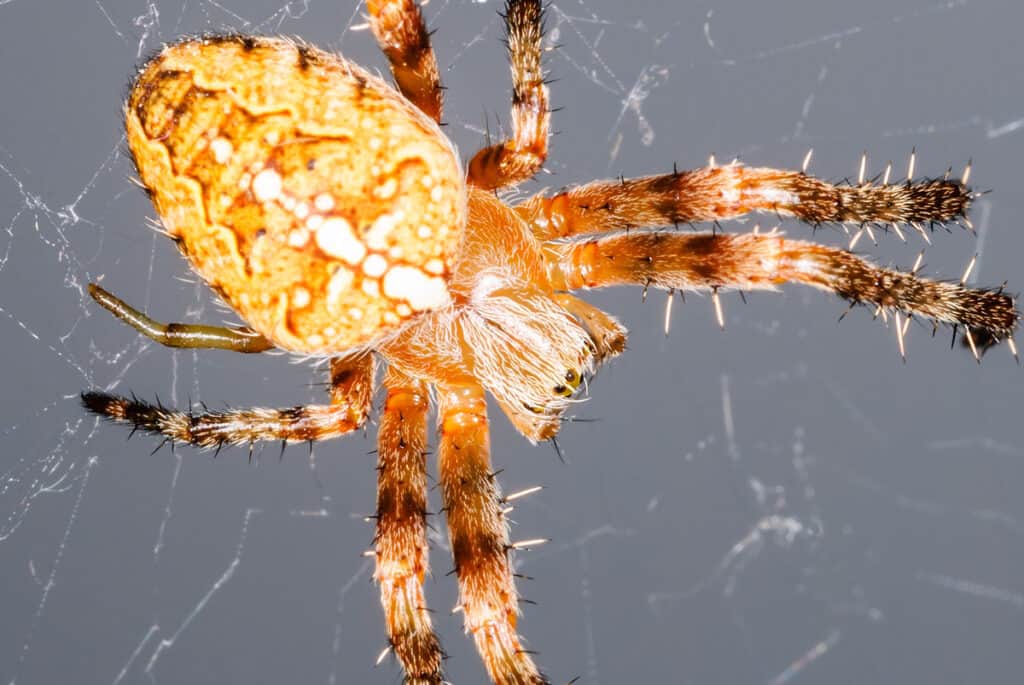
Also referred to as the European garden spider, the cross orbweaver is yet another common non-venomous spider in Los Angeles.
©Imfoto/Shutterstock.com
The cross orbweaver spider is a frequent uninvited guest in Los Angeles homes. Originally hailing from Western and Northern Europe, these spiders have migrated to North America and established their presence in the United States. Another common name for these arachnids is the European garden spider.
Their appearance might vary significantly between individuals, displaying colors from pale yellow to dark grey. Nonetheless, all of them sport distinctive white patterns on their dorsal abdomen, typically forming a cross shape with four or occasionally more segments.
In terms of size, female cross orbweavers are larger than males, measuring between 0.26 to 0.79 inches, while males range from 0.22 to 0.51 inches in length.
Their primary diet consists of flying insects, including flies and mosquitoes. To catch their prey, they construct intricate orb webs, which can span up to 15 inches in diameter. These large, elaborate webs, usually crafted by the females, are common sights in various environments such as gardens, meadows, and woodland clearings.
Although the cross orbweaver does possess venom, it’s mild and not harmful to humans or larger animals. The pain from an orbweaver bite can be likened to a bee sting.
7. Black and Yellow Garden Spider (Argiope aurantia)

A relatively large but harmless spider that you may find in Los Angeles is the black and yellow garden spider.
©Ron Rowan Photography/Shutterstock.com
The black and yellow garden spider is one of the showy spiders in the gardens of Los Angeles.
The females of this species boast a unique design, with their abdomens showcasing black and bright yellow symmetrical patches. Contrasting this, their legs transition from a reddish-brown base to black ends.
Meanwhile, the males appear less flamboyant, displaying modest yellow markings on their abdomens and adopting a smaller stature with brownish legs. Typically, females measure between 0.75 to 1.1 inches in body length, larger than males by up to three times.
Rather than seeking refuge in dense foliage or shelters, these spiders prefer to spin their webs in more open spaces, serving as a line of defense against pests in gardens and landscapes. Essentially, their predatory habits are a blessing, aiding in the protection of garden plants. Flying insects and grasshoppers are their favorite food items.
These garden allies pose no venomous threat to humans; thus, there’s no necessity to remove or harm them if you find them nestled in your garden. They usually refrain from biting unless provoked or harmed, and if they do bite, the experience is similar to the sting of a bee, causing minimal discomfort.
8. Long-Bodied Cellar Spider (Pholcus phalangioides)
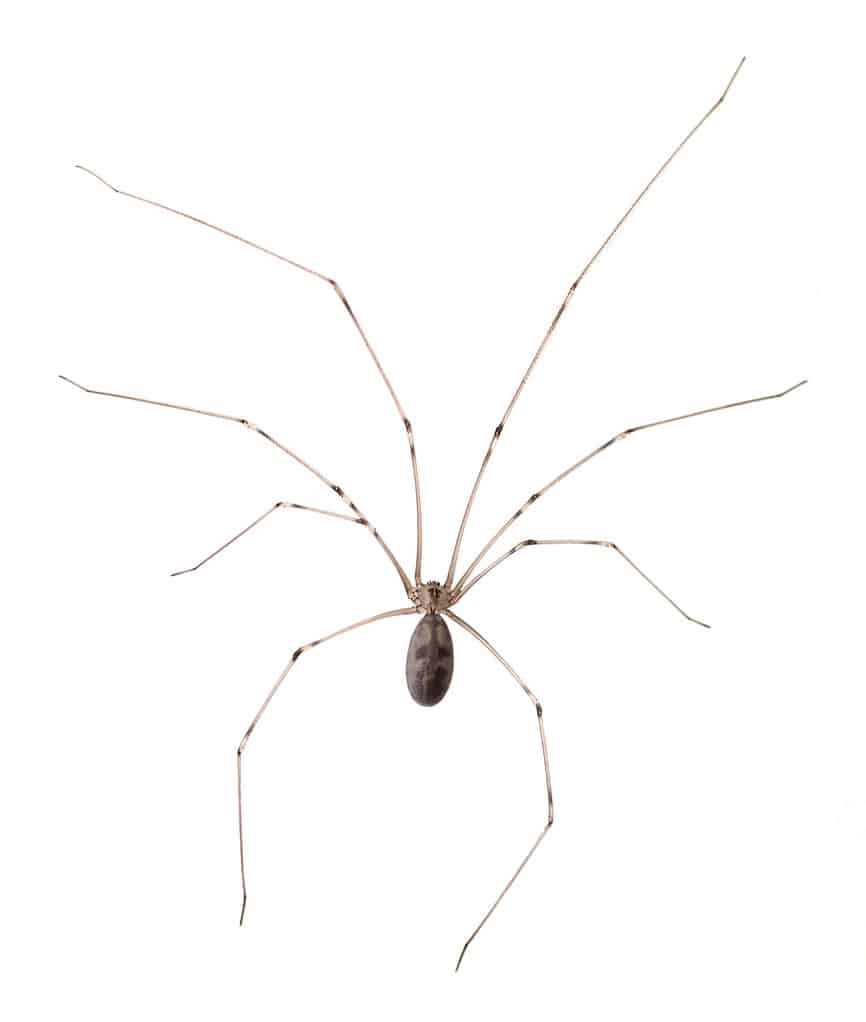
The legs of long-bodied cellar spiders are up to six times longer than their bodies! Despite the relatively menacing look of these spiders, they are harmless and don’t have venom.
©Melinda Fawver/Shutterstock.com
Residents of Los Angeles are no strangers to long-bodied cellar spiders, as they are commonly found in homes and buildings.
All cellar spiders possess simple, rounded bodies that vary in shade from light yellow to mild brown or gray. Characterized by their elongated, grey-white bodies and slender legs that are remarkably long, they are a common indoor inhabitant. These spiders have eight eyes organized in two groups of three on each side, with another two eyes situated between them.
Female cellar spiders have legs that span five to six times the length of their roughly 0.35-inch bodies, outstretching the slightly smaller males.
With a preference for quiet and shaded areas, these spiders are often found residing in basements, storage spaces, and even caves, where they feast upon other small arthropods, including insects and other spiders.
Despite their ability to multiply significantly, they bear no threat to humans. These spiders, devoid of venom, remain harmless and are not associated with biting incidents.
Summary of Spiders Crawling Around Los Angeles
| Spider | Scientific Name | Venomous? | |
|---|---|---|---|
| 1 | Chilean Recluse | Loxosceles laeta | Yes |
| 2 | Western Black Widow | Latrodectus hesperus | Yes |
| 3 | Brown Widow | Latrodectus geometricus | Yes |
| 4 | Yellow Sac Spider | Cheiracanthium inclusum | Yes |
| 5 | Common House Spider | Parasteatoda tepidariorum | No |
| 6 | Cross Orbweaver | Araneus diadematus | No |
| 7 | Black and Yellow Garden Spider | Argiope aurantia | No |
| 8 | Long-bodied Cellar Spider | Pholcus phalangioides | No |
The photo featured at the top of this post is © Jay Ondreicka/Shutterstock.com
Thank you for reading! Have some feedback for us? Contact the AZ Animals editorial team.







